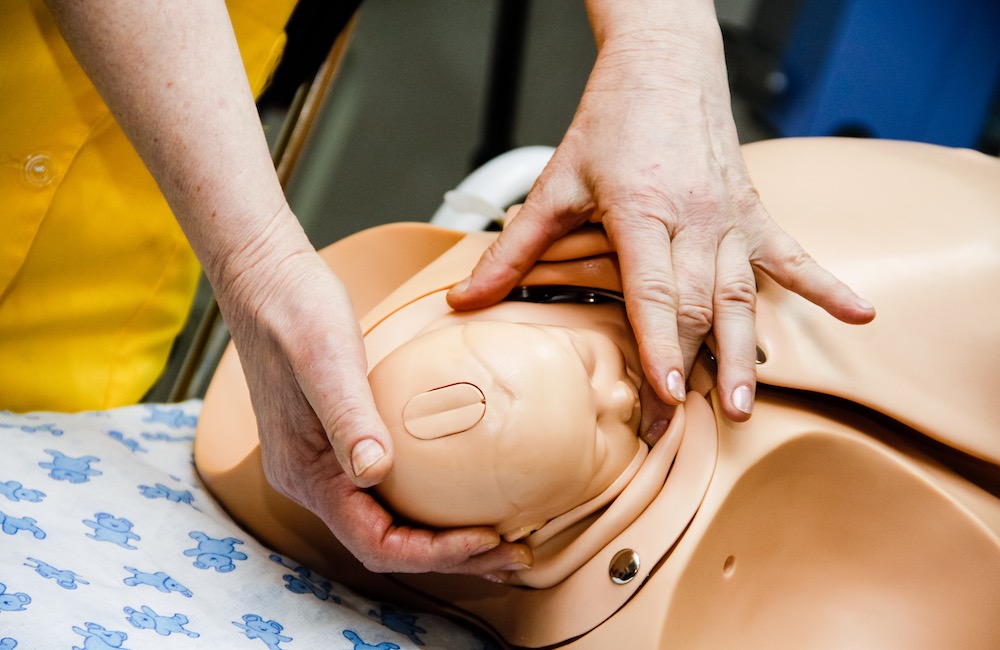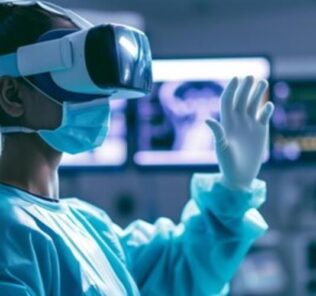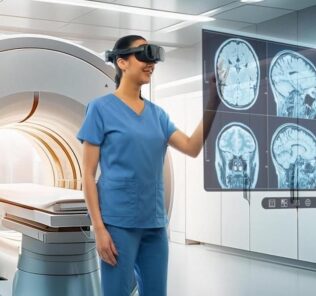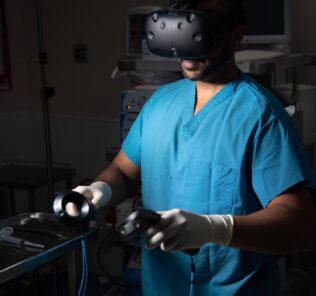A Two-Step Process for Choosing a Birthing Simulator
Simulated or real, there are so many ways to have a baby. A pregnant woman preparing for childbirth has several key decisions to make regarding the delivery of her baby. Where does she want to give birth – in the traditional hospital setting or in a birthing center? Regarding having a baby, the decisions pile up as every birth is unique, and women have choices; one size does not fit all. When simulating a birthing experience, healthcare simulation educators face even more options than mothers. This HealthySimulation.com article explains what these options are, and presents a two-step process for choosing OB simulation equipment.
In terms of healthcare simulation, questions as they relate to OB care, simulationists may find themselves asking: Does a clinical simulation scenario require a full-body manikin, or is a task trainer more appropriate? Should they employ a Simulated Patient (SP) with a wearable? Will this be an in-situ medical simulation session or will the training take place in the clinical simulation lab? What level of fidelity is required to meet the learning objectives? Again, one size does not fit all.
Ultimately, there are many tools available for healthcare simulation-based training in the field of obstetrics and new items seem to be added to the list on a daily basis. Several full-body birthing simulators are on the market. These pregnant manikins are capable of simulating both vaginal and C-section births.
Sponsored Content:
Task trainers or partial manikins are lifelike models of human body parts, such as the female pelvis. Task trainers can also be used to teach competency-based and procedural skills in obstetrics, such as hand maneuvers to resolve shoulder dystocia, instrument deliveries, breech delivery techniques, and management of postpartum hemorrhage. Additionally, part-task trainers allow for repeated practice of a specific obstetric skill, providing learners ample time to gain proficiency.
Wearable simulators are designed to be worn by an SP during healthcare simulation learning. Wearable simulators have the needed anatomic landmarks and associated physiology to allow a nonpregnant SP to become a pregnant patient. Some wearables have embedded technology that provides inconspicuous haptic signals to the SP, so they can authentically respond both verbally and non-verbally, to the current situation.
Wearable simulators elevate the integration of SPs in both formative and summative clinical simulation experiences allowing learners to really practice their assessment skills and authentically demonstrate their critical thinking proficiencies in a safe, controlled setting. Further, wearable simulators remove the traditional limitations of SP methodology and maximize simulation learning.
Screen-based or serious game simulations are available as a teaching strategy for obstetric skills as well. Plus, advancements in technology are making extended reality (XR) simulation options increasingly common. With so many options, deciding which methodology to employ can become challenging for simulationists.
Sponsored Content:
Step One: Identify the Learning Objectives for the Clinical Simulation
Simulationists looking to conduct an OB simulation must start with the why – what is the purpose of the healthcare simulation activity? Clearly stating the desired learning objectives provides guidance for all of the decisions that need to be made when designing a medical simulation-based learning activity. The objectives should be appropriate for the level of the learner. Novice learners can become overwhelmed and over-stimulated during immersive simulation activities. Using a lower level of fidelity initially, will decrease distractions and allow beginner learners to focus on the task at hand.
Obstetric simulation as a means to improve patient outcomes is generally focused in three areas: skill acquisition, interval training, and in-situ drills. Skill acquisition is a common goal of the obstetric simulation. These skills can range from basic or foundational skills to more advanced techniques or procedures that require a great deal of practice to develop. The following obstetrical skills are frequently introduced to learners in simulation:
- Postpartum Hemorrhage
- Shoulder Dystocia
- Breech Deliveries
- C-Section
- Umbilical Cord Prolapse
- Use of Forceps
- Teamwork & Communication
Step Two: Determine the Appropriate Modality and Level of Fidelity Based on the Stated Objectives
The modality selection often dictates the degree of immersion, level of fidelity, and the platform for learner interaction. Therefore, simulation educators must understand the implications of the chosen modality. Those tasked with designing the obstetric simulation will need to explore the benefits, potential challenges, and other considerations associated with each of the available clinical simulation modalities.
Criterion 4 of the Simulation Design Standard instructs simulationists to choose the simulation modality that best aligns with the stated objectives (INACSL, 2021). Modality is defined as simulated clinical immersion, in situ simulation, computer-assisted simulation, virtual reality, procedural simulation, and/ or hybrid simulation. These modalities may incorporate but are not limited to the following: standardized patients, manikins, haptic devices, avatars, partial task trainers, and so on (Lioce et al., 2020).
A high degree of variance exists within the literature in regards to naming and describing healthcare simulation modality categories: procedural vs. skills-based or task-oriented; clinical immersion vs scenario-based or high-fidelity; computer-based vs. screen-based or virtual; and standardized patient vs. simulated patient or participant.
Hybrid, blended, mixed- and multi-modal are all terms used to describe when two or more modalities are utilized in one clinical simulation activity. Inconsistency in the nomenclature of modality types leads to confusion during the design phase of the medical simulation, which may cause learner outcomes to go unmet (Carey & Rossler, 2022).
The lack of clarity surrounding the terminology used in naming and describing the categories of healthcare simulation modalities can lead to a bias among some educators toward using a particular modality; the choice of modality might be based on a level of familiarity with a specific modality or an unfounded assumption that the modality with the highest level of fidelity will yield the best results.
Operating under this misconception, a medical simulation educator might insist on using the new high-fidelity simulator for skills training. This will cause unnecessary wear and tear on the expensive equipment and might mean that the simulator is not available for a medical simulation activity with objectives more in line with that modality.
The healthcare simulation community would benefit from a taxonomy of simulation modalities that clearly categorizes and describes methods of delivery for simulation-based educational activities. This classification system would identify the intrinsic benefits, challenges, risks, opportunities, and consequences of each modality grouping, allowing simulation educators to select the most appropriate modality to meet the educational objectives or to adjust the training session according to the available modality options.
Advancements in technology feed the evolution of simulation modalities; the velocity of this change has been startling in recent years. Therefore, the modality categories need fluid boundaries, allowing for flexibility and evolution (Carey & Rossler, 2022).
Modalities / OB Simulation Equipment Options
The choice of modality impacts the level of physical fidelity or realism. Understanding the distinction between fidelity and modality is important. While these terms are related, they are independent variables that may or may not have a reciprocal relationship. High tech does not necessarily equate to high fidelity or an increased level of realism. Not every healthcare simulation requires the highest fidelity (Carey & Rossler, 2022).
The use of extended reality (XR) applications in healthcare simulation is increasing in popularity as the technology improves and becomes more cost-effective. Virtual reality (VR) refers to the recreation of environments or objects as complex, computer-generated images. Augmented reality (AR) is a technology that overlays digital information on objects or places in the real world for the purpose of enhancing the user experience.
AR is not virtual reality, that is, the technology that creates a totally digital or computer-created environment. Rather, AR combines reality and digital information, often in the form of digital overlays. In order for something to be considered AR, there must be graphics, sounds, or other sensations superimposed over a view of reality in real-time. To do this, AR companies use smartphones or AR glasses to project graphics or animations onto a user’s view. (Ryan et al., 2020).
Using the latest technology in holographic visualization, mixed reality (MR) brings digital learning content into the physical simulation space, allowing participants to link knowledge and skill through an entirely new hands-on training experience (Gaumard, 2022). Haptic systems refer to those replicating the kinesthetic and tactile perception and are often used in conjunction with both VR and AR systems in order to increase fidelity. This tactile feedback technology has been around for decades, but advances in haptic technology allow for integration with XR platforms, yielding a powerful tool for learner engagement (Smithsonian, 2018).
Determinations about the degree of fidelity and the implementation of this fidelity need to be determined through the examination of several factors including:
- Learner level
- Learning objectives
- Available time and resources
- Available equipment
- Desired learning outcomes
- Clinical significance
Simulationists are encouraged to keep apprised of the growing inventory of OB simulation equipment by visiting vendors in exhibit halls during conferences, perusing the internet, and networking with others in the healthcare simulation world. The list below is certainly not all-inclusive, but this menu illustrates there are plenty of options available.
Task Trainers
- Sophie and Sophie’s Mum Birth Simulator Version 4.0
- Lucy and Lucy’s Mum Instrumental Delivery Birth Simulator
- 3B Scientific Birthing Simulator
- Simulaids Obstetrical Manikin
- Limbs & Things PROMPT Flex Birthing Simulator
- Desperate Debra Simulator
Full-Body Birthing Manikins
- Gaumard VICTORIA
- Gaumard NOELLE
- RealMom 2.0
- Lucina from CAE Healthcare
- Life/form Lucy Maternal and Neonatal Birthing Simulator
Mixed Modality
- SP with Avkin Wearable AvBirth
- Mama Natalie by Laerdal Global
- PRONTO Pack with Parto Pants
- Limbs & Things PROMPT Flex Birthing Simulator
- 3B Scientific SIMone with Haptic Response Technology
- LucinaAR from CAE Healthcare
- Screen-Based / Game-Based Simulation:
- Montgomery College – Postpartum Hemorrhage Case
- Ryerson University – Prenatal, Labor & Delivery, and Postpartum Cases
- Super Divya – Interactive, Digital Storytelling Instructional Comic Series
Extended Reality (XR) Simulation
- Obstetric MR (Mixed Reality) from Gaumard
- Oxford Medical Simulation (OMS) Virtual Reality (VR) Obstetric
- Hemorrhage Virtual Reality Simulation from Health Scholars
- Augmented Reality (AR) Overlays
Wearables
- SP with Avkin Wearable AvBirth
Mothers expect their labor and delivery team to be prepared for complications and emergencies Healthcare simulation is a critical part of the comprehensive strategy to improve patient care in obstetrics and is used extensively in both medical resident and nursing training programs. Healthcare simulation-based education is becoming a key component of local, regional, and national programs being implemented to improve maternal obstetric outcomes.
This increased emphasis on the use of simulation is causing a wave of new obstetric simulation products to hit the market. Simulationists need to be savvy in their ability to select the right product for the task at hand while considering the most appropriate modality to meet the desired outcomes for the learners.
AWHONN - Association of Women’s Health, Obstetric and Neonatal Nurses. (2022, May 25). 2021 Maternal Mortality Survey Report. Relias. Retrieved September 11, 2022, from https://www.relias.com/resource/maternal-mortality-survey-report?aliId=0
Carey, J. & Rossler, K. (2022). The How, When, and Why of High-Fidelity Simulation. In: StatPearls [Internet]. Treasure Island (FL): StatPearls Publishing; 2022 Jan-. Available from: https://www.ncbi.nlm.nih.gov/books/NBK559313/
The Chang School, Toronto Metropolitan University. (n.d.). Game-Based Learning. DES: Game-based Learning. Retrieved November 1, 2022, from https://de.ryerson.ca/games/
DiCioccio H. C. (2021). OB simulation during the COVID-19 pandemic. MCN. The American journal of maternal child nursing, 46(5), 299. https://doi.org/10.1097/NMC.0000000000000744
Gaumard. (2022). Introducing Obstetric MR Mixed Reality Training System. Gaumard simulators for Health Care Education. (n.d.). Retrieved November 2, 2022, from https://www.gaumard.com/obstetricmr
INACSL Standards Committee, Watts, P.I., McDermott, D.S., Alinier, G., Charnetski, M., & Nawathe, P.A. (2021, September). Healthcare Simulation Standards of Best PracticeTM Simulation Design. Clinical Simulation in Nursing, 58, 14-21. https://doi.org/10.1016/j.ecns.2021.08.009.
Kalra, A., Subramaniam, N., Longkumer, O., Siju, M., Jose, L. S., Srivastava, R., Lin, S., Handu, S., Murugesan, S., Lloyd, M., Madriz, S., Jenny, A., Thorn, K., Calkins, K., Breeze-Harris, H., Cohen, S. R., Ghosh, R., & Walker, D. (2022). Super Divya, an interactive digital storytelling instructional comic series to sustain facilitation skills of labor and Delivery Nurse Mentors in Bihar, India—a pilot study. International Journal of Environmental Research and Public Health, 19(5), 2675–2689. https://doi.org/10.3390/ijerph19052675
Lioce L. (Ed.), Lopreiato J. (Founding Ed.), Downing D., Chang T.P., Robertson J.M., Anderson M., Diaz D.A., and Spain A.E. (Assoc. Eds.) and the Terminology and Concepts Working Group (2020), Healthcare Simulation Dictionary –Second Edition. Rockville, MD: Agency for Healthcare Research and Quality; September 2020. AHRQ Publication No. 20-0019. DOI: https://doi.org/10.23970/simulationv2
Montgomery College, M. (2022). Nursing simulation library. Nursing Simulation Library | Montgomery College, Maryland. Retrieved November 1, 2022, from https://www.montgomerycollege.edu/academics/departments/nursing-tpss/nursing-simulation-scenario-library.html
Oxford Medical Simulation. (2021, September 30). Can maternity simulation really be pain-free? Oxford Medical Simulation. Retrieved November 1, 2022, from https://oxfordmedicalsimulation.com/future-of-simulation/can-maternity-simulation-really-be-pain-free/
Ryan, R., Ryan, G., & Higgins, M. F. (2020, January 1). Exploring virtual and augmented reality simulation in obstetrics and gynaecology training; a qualitative study. medRxiv. Retrieved November 2, 2022, from https://www.medrxiv.org/content/10.1101/2020.12.13.20248133v1
Smithsonian Magazine. (2018, December 28). Here's what the future of haptic technology looks (or rather, feels) like. Smithsonian.com. Retrieved November 2, 2022, from https://www.smithsonianmag.com/innovation/heres-what-future-haptic-technology-looks-or-rather-feels-180971097/
Thoma, M. E., & Declercq, E. R. (2022). All-cause maternal mortality in the US before vs during the COVID-19 pandemic. JAMA Network Open, 5(6). https://doi.org/10.1001/jamanetworkopen.2022.19133
Jeanne Carey is the Director of Simulation at Baylor University Louise Herrington School of Nursing in Dallas, Texas. She holds advanced certification as a simulation educator and has 10 years of experience in all aspects of simulation, including the development and implementation of new simulation-based learning activities, training of simulation facilitators, and recruitment and management of standardized patients. Carey and the LHSON Simulation Team created the Two-Heads-Are-Better-Than-One (2HeadsR>1) strategy for role assignment in simulation. She is active in several simulation organizations and currently serves as an INACSL Nurse Planner.
Sponsored Content:




















